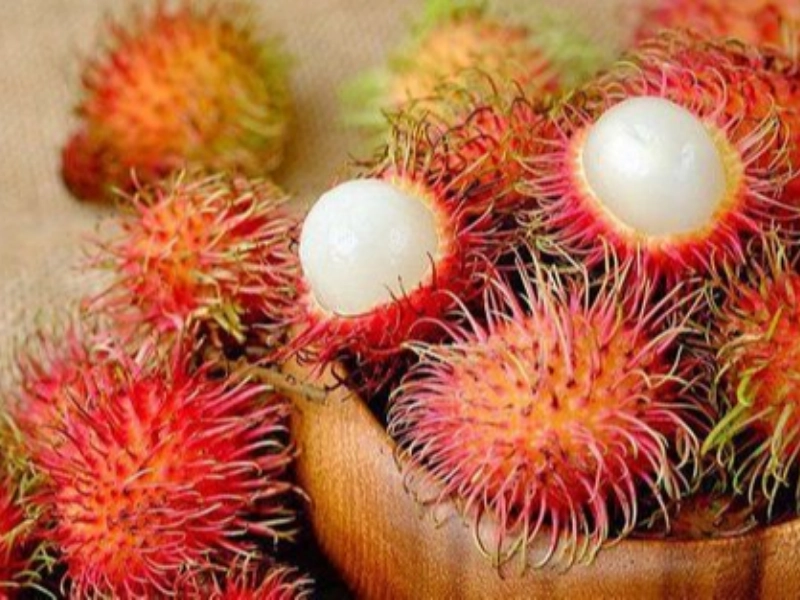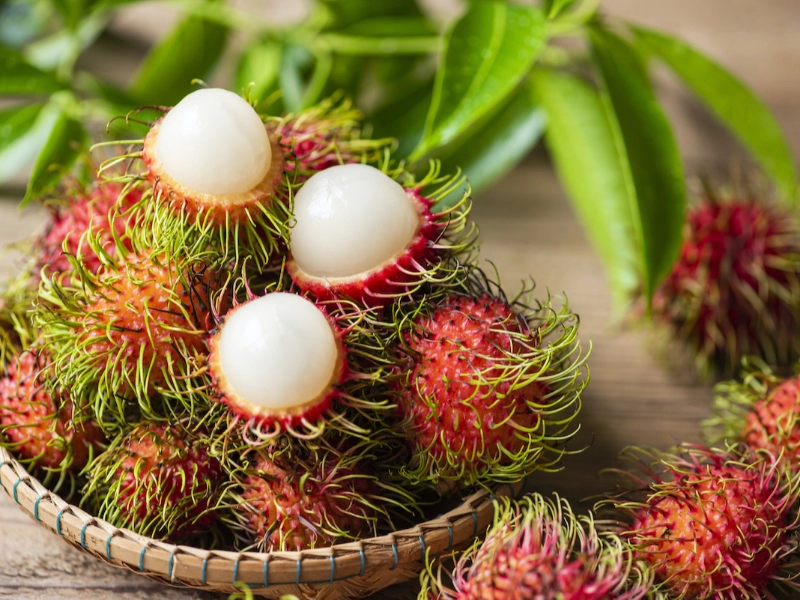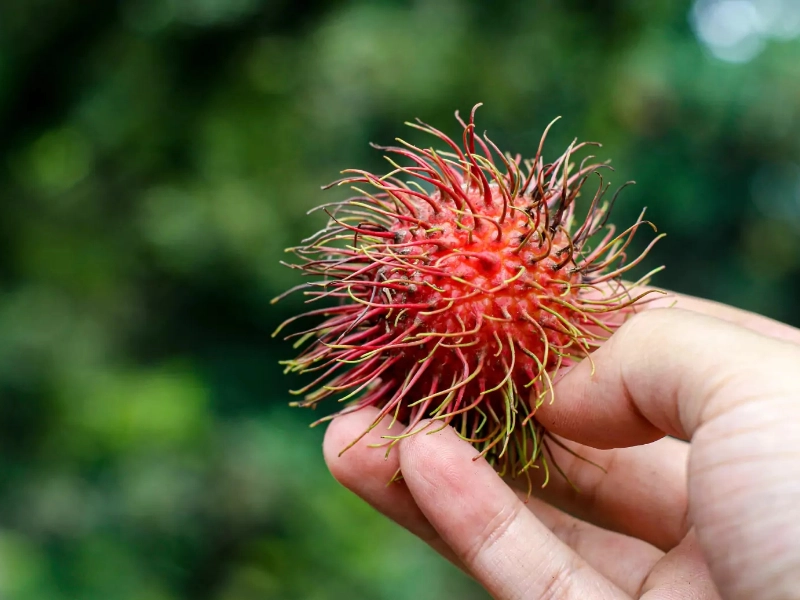Tropical fruit with unusual look and sweet, luscious flesh is rambutan. Appropriate storage is crucial if one wants to appreciate its great taste at finest. Whether you bought rambutan from a shop or just picked it from your garden, proper storage can help to maximise its taste and freshness. This tutorial will look at several ways to store rambutan, including best conditions, refrigeration methods, and preservation advice, thereby extending the lifetime of this unusual fruit.

 One of the best methods to keep rambutan freshest for longer is refrigeration. If you want to eat the fruit in a week, refrigeration greatly increases its shelf life. To get any dirt or residue from the rambutan, first softly rinse it under lukewarm water. To stop too much moisture, which can cause mould development, pat the fruits dry with a fresh towel.
Once dried, arrange the rambutan in a permeable container—such as a mesh bag or a perforated plastic container. Steer clear of airtight containers since these could encourage deterioration and trap moisture. Usually with greater humidity levels, store the container in the crisper drawer of your refrigerator. This environment keeps the fruit from drying out and helps to retain its wetness and crispness. Check the rambutan often for any indications of spoiling; remove any damaged fruits to stop them from influencing the others.
One of the best methods to keep rambutan freshest for longer is refrigeration. If you want to eat the fruit in a week, refrigeration greatly increases its shelf life. To get any dirt or residue from the rambutan, first softly rinse it under lukewarm water. To stop too much moisture, which can cause mould development, pat the fruits dry with a fresh towel.
Once dried, arrange the rambutan in a permeable container—such as a mesh bag or a perforated plastic container. Steer clear of airtight containers since these could encourage deterioration and trap moisture. Usually with greater humidity levels, store the container in the crisper drawer of your refrigerator. This environment keeps the fruit from drying out and helps to retain its wetness and crispness. Check the rambutan often for any indications of spoiling; remove any damaged fruits to stop them from influencing the others.
 If you intend to eat rambutan a few days from now, room temperature storage is a good choice. Still, it's crucial to pick the correct environment to stop early spoiling. Choose a cool, dry place free from direct sunlight since heat can hasten ripening and cause more rapid deterioration.
To let air flow, arrange the rambouts in a shallow bowl or basket. Stacking the fruits on top of one another runs the danger of spoiling and results in bruising. Every day monitoring of the fruits is crucial since room temperature storage accelerates ripening. Remove any fruits you find beginning to go right away to save the others.
If you intend to eat rambutan a few days from now, room temperature storage is a good choice. Still, it's crucial to pick the correct environment to stop early spoiling. Choose a cool, dry place free from direct sunlight since heat can hasten ripening and cause more rapid deterioration.
To let air flow, arrange the rambouts in a shallow bowl or basket. Stacking the fruits on top of one another runs the danger of spoiling and results in bruising. Every day monitoring of the fruits is crucial since room temperature storage accelerates ripening. Remove any fruits you find beginning to go right away to save the others.
 Freezing is a great choice for anyone wishing to keep rambutan for a longer length of time. Preserving the taste and texture of the fruit by freezing lets you enjoy it later in desserts, smoothies, or as a cool snack. First wash the fruits and cut off the skin to get ramboutan ready for freezing. One can accomplish this by softly peeling the outer shell to expose the luscious flesh inside.
Peel first; then cut the rambutan in half and extract the seed. On a parchment paper-lined baking sheet, place the flesh in a single layer such that the pieces do not come into touch. This stage keeps the fruit from grouping together in cold storage. The rambutan pieces should freeze until solid, roughly two hours. Transfer the frozen bits then to an airtight freezer bag or container, noting the date. Retaining its great taste and texture, frozen rambutan can keep up to six months.
Freezing is a great choice for anyone wishing to keep rambutan for a longer length of time. Preserving the taste and texture of the fruit by freezing lets you enjoy it later in desserts, smoothies, or as a cool snack. First wash the fruits and cut off the skin to get ramboutan ready for freezing. One can accomplish this by softly peeling the outer shell to expose the luscious flesh inside.
Peel first; then cut the rambutan in half and extract the seed. On a parchment paper-lined baking sheet, place the flesh in a single layer such that the pieces do not come into touch. This stage keeps the fruit from grouping together in cold storage. The rambutan pieces should freeze until solid, roughly two hours. Transfer the frozen bits then to an airtight freezer bag or container, noting the date. Retaining its great taste and texture, frozen rambutan can keep up to six months.
Another great method to preserve rambutan is by dehydrating it, particularly if you like munching on dried goods. Dehydration reduces moisture, so stopping the formation of mould and germs and enabling extended shelf life. Start by cleaning and peeling the rambouts, then cut off the seeds to dry them. To guarantee equal drying, cut the flesh tiny, homogeneous pieces. You might air dry the slices, use an oven or a food dehydrator. Set the dehydrator to the suggested fruit temperature—usually approximately 135°F (57°C)—then run it until the rambutan is totally dry and leathery. If using an oven, set it at the lowest temperature and leave the door somewhat open to let moisture out. Store the rambutan slices in an airtight container in a cold, dark spot once they have dried. A good snack or addition to trail mixes and grains is dried rambutan.
Common storage errors must be avoided if one wants rambutan to be as fresh as possible. Washing the fruit before storing is one big mistake. Rambutan should be washed shortly before eating since too much moisture could encourage mould development. Rambutan can also hasten ripening and deterioration by being kept with other fruits that release ethylene gas, such bananas and apples. Separate rambutan from these fruits to extend its freshness. Ignoring to routinely check for spoiling is another error. Check your kept rambutan for any indications of deterioration, such soft areas or discolouration on a regular basis. Eliminating rotten fruit quickly will assist to preserve the others. Finally, keep rambutan away from strong temperature swings since these will compromise its taste and texture. Being aware of these typical mistakes will help you to properly store rambutan and savour its delicious taste for more length of time.
Once you have rambutan stored effectively, think about creatively enjoying this wonderful fruit. Adding fresh rambutan to fruit salads, smoothies, or desserts gives your food a tropical spin. Rambutan goes great with yoghurt or cottage cheese for a reviving snack. Frozen or dried rambutan can be used to baked products, such bread or muffins, imparting a distinctive taste and texture. A healthy on-the-go snack is dried rambouts mixed into energy bars or oats. Experimenting with several recipes and applications can help you maximise your stored rambutan and enjoy its delicious flavour in several forms.